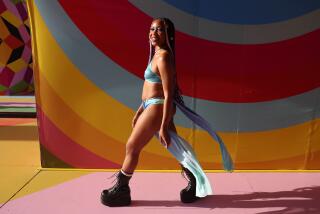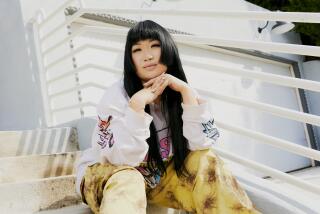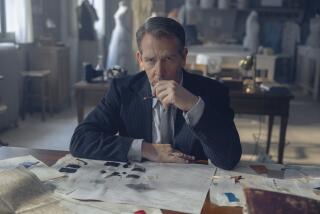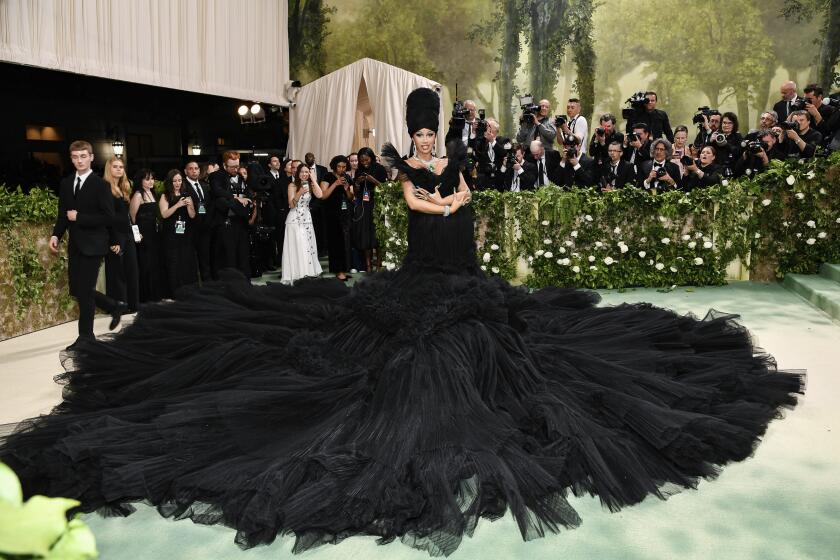Our fashion critic reviews ‘Making the Cut’s’ winning looks: ‘Coachella-worthy’
The following story contains spoilers from the seventh and eighth episodes of Amazon’s “Making the Cut.” Read our reviews of last week’s winning looks here.
With the bulk of the episodes in the rearview mirror and just five contestants left, the pace of “Making the Cut” is changing noticeably. I’m not bringing this up to critique the show — that’s not at all why I’m here — but to highlight one of the fun things about watching a show on Amazon Prime: the X-ray feature that appears when you hover over the screen. In addition to identifying who or what is on the screen at any given time (including but not limited to the contestants, hosts and judges), it serves up some wonderfully random trivia.
As the segments featuring hosts Tim Gunn and Heidi Klum gallivanting around Tokyo grow longer and the runway shows shorter, I’ve found myself hovering over the trivia entries more frequently. As a result, I’ve learned about the history of Singer sewing machines, the story behind the Edo-Tokyo Open Air Architecture Museum and that Tim Gunn’s name translates into Japanese as “Caesar’s dream.” (You can bet your bottom dollar when I hit my first post-pandemic cocktail party I’ll be trotting out the fact that the Japanese have three different words to refer to different kinds of umbrellas.) The X-ray feature doesn’t have anything to do with the fashion specifically, but it’s an added layer of fun you might want to explore next time Heidi and Tim disappear into a sake bar or face off in virtual-reality combat.
L.A. Times TV editor Matt Brennan interviews ‘Making the Cut’ and ‘Project Runway’ star Tim Gunn about his mentorship style.
Episode 7: A fun one-piece with two tiny problems
The challenge in this episode involved creating a pair of looks to be featured in a digital marketing campaign. As Caesar’s dream put it in introducing the challenge to the designers: “To be successful in this business, you must be able to present your brand in a clear and captivating manner.” The episode’s winner, Jonny Cota, did just that, pulling inspiration from a plant-filled part of the aforementioned museum grounds for a pair of floral-inspired looks and a campaign he dubbed “Tokyo Punks.” The runway look was a black-and-white floral print dress (rinsed in coffee to dull the contrast down) that might be the most delicately feminine-looking garment Cota’s turned out, while the one that was available for purchase (albeit briefly) on the Amazon Fashion website was a unisex jumpsuit with an allover pattern that could have been interpreted as riffs on a flower blossom.
Details on the belted indigo and white cotton one-piece outfit ($89.90) included a drop crotch, four large faux-leather contrast-colored patch pockets and blue-and-white-striped webbing down the outside of the arms. Jumpsuits are all the rage, and if music festivals were actually happening right now, Cota’s version, with its relaxed inseam and super roomy pockets, would probably be popular. But while I liked the look, I didn’t love it. The biggest reason — literally and figuratively — were those four outsized zippered pockets on the front, each the size of a first-generation iPad. If they’d been in the same fabric as the rest of the jumpsuit, the pockets probably would have gone all but unnoticed. Instead they make the wearer look a bit like a human bulletin board tacked with four pieces of paper. The other detail that’s keeping me from giving it my full-throated endorsement is the solid swath of blue fabric running down the back of the jumpsuit that, when it reaches the bottom of the inseam, makes the saggy drop crotch look like a very full diaper.
The takeaway: Cota’s jumpsuit was a fun, Coachella-worthy one-piece — albeit with two tiny problems.
Times fashion critic Adam Tschorn offers his thoughts on Episodes 5 and 6 of Amazon’s fashion competition ‘Making the Cut.’
Episode 8: Cartoon trousers and a superhero office cape
The eighth episode challenged the remaining four designers to showcase how their brand has evolved since the show began, and the victor turned out to be the designer whose brand DNA has seemed stubbornly resistant to change over the previous seven episodes — Esther Perbandt. Her winning look consisted of two pieces: a pair of black cropped trousers that pulled inspiration from classic Hollywood movies paired with a chiffon cape top. Both pieces riffed on menswear (if you’ve been watching the show you know this — and the color black — are Perbandt’s thing), and, as with her episode two winning look, I liked one but not both of the pieces.
Thanks to the stiff-looking fabric, the raw-edged outseam and the wide but cropped trouser leg, the pants ($64.90) felt a bit cartoonish. If by Hollywood inspiration she was going for was Buster Keaton or Charlie Chaplin, mission accomplished. Plus, the side-tying fabric belt had a confusing pleated half-skirt on one side that circled all the way around the back but in the front ended smack in the middle. It was an unnecessary flourish of femininity that came across as a tacked-on afterthought.
Above the side-tying belt, it was a whole different story, though. The second piece of Perbandt’s ensemble was a more seamless melding of masculine and feminine: a light and breezy chiffon and cotton cape top ($64.90) that riffed on the classic men’s dress shirt silhouette. The foundation of the garment was a crisp, white sleeveless cotton shirt (colorwise a marked departure for the designer) complete with front button placket and a shrunken version of the dress shirt collar. Layered over that was a diaphanous white chiffon cape that fell to about the breastbone in the front and opened at the sides to allow the skin of bare arms to peek through. Helping telegraph the masculine-meets-feminine vibe even further is a shrunken black poplin necktie (it’s removable) that falls to just the point where the chiffon on the front of the top gives way to the cotton dress shirt. It was an artful detail that spoke volumes about the designer’s ability to seamlessly meld contrasting fabrics and inspirations together.
The takeaway: A split decision thanks to cartoonish trou balanced by a super-heroic, contrast-melding office cape.
More to Read
The complete guide to home viewing
Get Screen Gab for everything about the TV shows and streaming movies everyone’s talking about.
You may occasionally receive promotional content from the Los Angeles Times.







